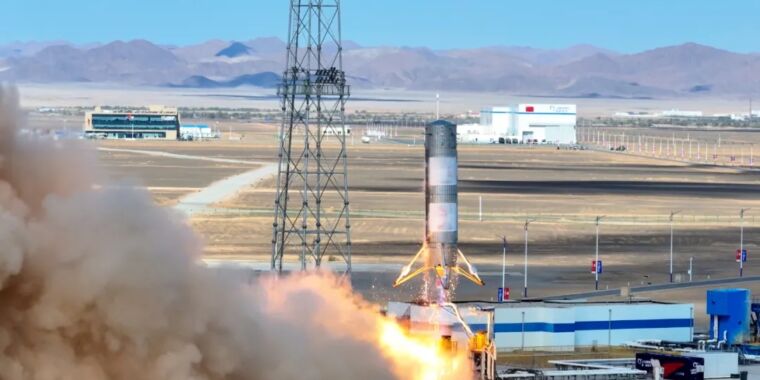Welcome to Issue 7.11 of the Rocket Report! Beyond the companies owned by American billionaires, the most compelling developments in reusable rockets are coming from China’s quasi-commercial launch industry. This industry is no longer nascent. After initially relying on solid-fuel rocket engines that appear to have been derived from Chinese military rockets, privately funded Chinese launch companies are testing larger launchers, with varying degrees of success, and are now conducting jump tests reminiscent of SpaceX’s Grasshopper and F9R Dev1 programs more than a decade ago.
As always, we are We welcome readers' contributions.If you don't want to miss a release, please subscribe using the box below (the form will not appear on AMP-enabled versions of the site). Each report will include information on small, medium and heavy rockets as well as a quick look at the next three launches on the calendar.

Landspace is getting closer to making a reusable rocket. Chinese private space company Landspace has completed a 10-kilometer (33,000-foot) vertical takeoff and landing test on its Zhuque-3 (ZQ-3) reusable rocket test stand, including a mid-flight engine re-ignition in near-hypersonic conditions, Aviation Week and Space Technology ReportsThe 18.3-meter-long (60-foot-long) vehicle blasted off from the Jiuquan launch base in northwest China, climbed to an altitude of 10,002 meters (3,300 feet), descended vertically and achieved a propulsive landing on the target 3.2 kilometers (2 miles) from the launch pad. Notably, the rocket’s methane-fueled variable-thrust engine was intentionally shut down in flight and then reignited for landing, with the engines set to power the booster’s future full return flights. According to Landspace, the experimental booster used grid fins and cold gas thrusters to control itself while its main engine was idle.
“All indicators are consistent with the expected design.” …Landspace hailed the test as a milestone on the company’s path to launching its next rocket, the Zhuque-3, as soon as next year. Using nine methane-fueled main engines, the Zhuque-3 will initially be able to deliver 21 metric tons (46,300 pounds) of payload to low Earth orbit with its booster flying in a disposable mode. In 2026, Landspace aims to begin recovering the Zhuque-3’s first-stage boosters for reuse. Landspace is one of several Chinese companies working hard on reusable rocket designs. Another Chinese company, Deep Blue Aerospace, says it plans to conduct a 100-kilometer (62-mile) suborbital test of a reusable booster soon, ahead of the first flight of its medium-class Nebula-1 rocket next year. (Submitted by Ken the Bean)
Isar Aerospace sets a low bar for success on first launch. Daniel Metzler, CEO of German launch company Isar Aerospace, said the Spectrum rocket's maiden flight would be successful if it did not destroy the launch site. European Space Flight ReportsDuring. Interview at Handelsblatt Innovation ConferenceMetzler was asked what he considered a successful inaugural flight for Spectrum. “For me, the first flight is a success if we don’t blow up the launch site,” Metzler explained. “That’s probably the thing that sets us back the most in terms of technology and time.” That tempering of expectations sounds remarkably similar to comments Elon Musk made about SpaceX’s first Starship flight last year.
In the catbird seat? … Isar Aerospace may be in position to become the first in a new crop of European commercial launch companies to attempt their first orbital flight. Another German company, Rocket Factory Augsburg, recently abandoned its chances of launching this year after its first booster rocket caught fire and collapsed during a test at a launch site in Scotland. Isar plans to launch its two-stage Spectrum rocket, designed to carry up to 1,000 kilograms (2,200 pounds) of payload into low Earth orbit, from Norway’s Andøya spaceport. Isar has not announced a timetable for Spectrum’s first flight, but there are indications that the publicity-shy company is testing hardware at the Norwegian spaceport. (Submitted by Ken the Bean)
The FAA will introduce new rules on orbital debris. The FAA is moving forward with efforts to establish rules for disposing of upper stages as another upper stage of the Centaur rocket disintegrates in orbit, Space News ReportsThe FAA released a draft rule on the issue for public comment a year ago, and the head of the agency’s commercial spaceflight division recently said the rules were “a top priority for our organization.” The rules would direct launch operators to dispose of upper stages in one of five ways, from controlled reentry to placement in graveyard or “disposal” orbits that are not typically used by operational satellites. One change the FAA might make to the draft rule is to reduce the timeline required for an uncontrolled reentry of a discarded upper stage from a maximum of 25 years to a shorter timeline. “We’ve had a lot of comments saying it should be much shorter,” said Kelvin Coleman, head of the FAA’s Office of Commercial Spaceflight. “We’re taking that into consideration.”
Higher levels are a problem. … Several recent disintegrations involving spent upper stages in orbit have highlighted concerns that dead rocket bodies can create unnecessary space debris. Last month, the upper stage of a Chinese Long March 6A rocket disintegrated in low Earth orbit, creating at least 300 pieces of space debris. More recently, a Centaur upper stage separated from a United Launch Alliance Atlas V rocket in a much higher orbit, creating more than 40 pieces of debris. It was the fourth time a ULA Centaur upper stage has disintegrated since 2018. (Submitted by Ken the Bean)

“Extreme travel lover. Bacon fanatic. Troublemaker. Introvert. Passionate music fanatic.”







More Stories
A fossilized creature may explain a puzzling drawing on a rock wall.
MrBeast Sued Over ‘Unsafe Environment’ on Upcoming Amazon Reality Show | US TV
Watch comets Lemmon and SWAN approach Earth today